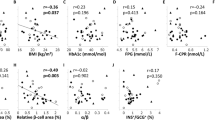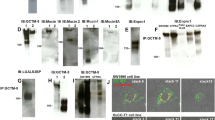Abstract
Fetal antigen 1 (FA1) is a glycoprotein containing six epidermal growth factor (EGF)-like repeats. It is closely similar to the protein translated from the human delta-like (dlk) cDNA and probably constitutes a proteolytically processed form of dlk. dlk is homologous to theDrosophila homeotic proteinsdelta andnotch and to the murine preadipocyte differentiation factor Pref-1. These proteins participate in determining cell fate choices during differentiation. We now report that FA1 immunoreactivity is present in a number of neuroectodermally derived tumours as well as in pancreatic endocrine tumours. A negative correlation between FA1 and glucagon immunoreactants in these tumours prompted a reexamination of FA1 immunoreactants during fetal pancreatic development. At the earliest stages of development, FA1 was expressed by most of the non-endocrine parenchymal cells and, with ensuing development, gradually disappeared from these cells and became restricted to insulin-producing beta cells. Throughout development FA1 was not detected in endocrine glucagon, somatostatin or pancreatic polypeptide cells. Moreover, developing insulin cells that coexpressed glucagon were negative for FA1. Thus, there was a negative correlation between FA1 and glucagon both in tumours and during development. These results, together with FA1/dlk's similarity with homeotic proteins, point to a role of FA1 in islet cell differentiation.
Similar content being viewed by others
References
Alpert S, Hanahan D, Teitelmann G (1988) Hybrid insulin genes reveal a developmental lineage for pancreatic endocrine cells and imply a relationship with neurons. Cell 53:295–308
Berry CL (1980) The examination of embryonic and fetal material in diagnostic histopathology laboratories. J Clin Pathol 33: 317–326
Carpenter G, Cohen S (1990) Epidermal growth factor. J Biol Chem 265:7709–7712
Cooper MJ, Hutchins GM, Cohen PS, Helman LJ, Mennie RJ, Israel MA (1991) Human neuroblastoma tumour cell lines correspond to the arrested differentiation of chromaffin adrenal medullary neuroblasts. Cell Growth Differ 1:149–159
Fay TN, Jacobs I, Teisner B, Poulsen O, Chapman MG, Stabile I, Bohn H, Westergaard JG, Grudzinskas JG (1988) Two fetal antigens (FA-1 and FA-2) and endometrial proteins (PP12 and PP14) isolated from amniotic fluid; preliminary observations in fetal and maternal tissues. Eur J Obstet Gynecol Reprod Biol 29:73–85
Fehon RG, Kooh PJ, Rebay I, Regan CL, Xu T, Muskavitch MAT, Artavanis-Tsakonas S (1990) Molecular interactions between the protein products of the neurogenic locinotch anddelta, two EGF-homologous genes inDrosophila. Cell 61: 523–534
Guz Y, Montminy MR, Stein R, Leonard J, Gamer LW, Wright CVE, Teitelman G (1995) Expression of murine STF-1, a putative insulin gene transcription factor in b cells of pancreas, duodenal epithelium and pancreatic exocrine and endocrine progenitors during ontogeny. Development 121:11–18
Helman LJ, Sack N, Plon SE, Israel MA (1990) The sequence of an adrenal specific human cDNA, pG2. Nucleic Acids Res 18: 685
Jensen CH, Teisner B, Højrup P, Rasmussen HB, Madsen OD, Nielsen B, Skjødt K (1993) Studies of the isolation, structural analysis and tissue localization of fetal antigen 1 and its relation to a human adrenal-specific cDNA, pG2. Hum Reprod 8: 635–641
Jensen CH, Krogh TN, Højrup P, Clausen PP, Skjødt K, Larsson L-I, Enghild JJ, Teisner B (1994) Protein structure of fetal antigen 1 (FA1). A novel circulating human epidermal-growth-factor-like protein expressed in neuroendocrine tumours and its relation to gene products of dlk and pG2. Eur J Biochem 225:83–92
Jonsson J, Carlsson L, Edlund T, Edlund H (1994) Insulin-promoter-factor 1 is required for pancreas development in mice. Nature 371:606–609
Krijger RR de, Aanstoot JH, Kranenburg F, Reinhard M, Visser WJ, Bruining GJ (1992) The midgestational human fetal pancreas contains cells coexpressing islet hormones. Dev Biol 153:368–375
Krusius T, Gehlsen KR, Rouslahti E (1987) A fibroblast chondroitin sulphate proteoglycan core protein contains lectin-like and growth factor-like sequences. J Biol Chem 262:13120–13125
Laborda J, Sausville EA, Hoffman T, Notario V (1993) Dlk, a putative mammalian homeotic gene differentially expressed in small cell lung carcinoma and neuroendocrine tumor cell line. J Biol Chem 268:3817–3820
Larsson L-I (1988) Immunocytochemistry: theory and practice. CRC Press, Boca Raton, Fl, USA
Larsson L-I, Hougaard DM (1994) Coexpression of islet hormones and messenger RNAs in the human foetal pancreas. Endocrine 2:759–765
Larsson L-I, Grimelius L, Håkanson R, Rehfeld JF, Stadil F, Holst J, Angervall L, Sundler F (1975) Mixed endocrine pancreatic tumors producing several peptide hormones. Am J Pathol 79: 271–284
Le Douarin NM, Fontaine-Pérus J (1981) The neural crest and the digestive tract: developmental relationships. In: Bloom SR, Polak JM (eds) Gut hormones, 2nd edn. Churchill-Livingstone, Edinburgh, pp 107–118
Lee YL, Helman L, Hoffman T, Laborda J (1995) Dlk, pG2 and Pref-1 mRNAs encode similar proteins belonging to the EGF-like superfamily— identification of polymorphic variants of this RNA. Biochim Biophys Acta 1261:223–232
Lukinius A, Ericsson JLE, Grimelius L, Korsgren O (1992) Ultrastructural studies of the ontogeny of fetal human and porcine endocrine pancreas, with special reference to colocalization of the four major islet hormones. Dev Biol 153:376–385
Madsen OD, Larsson L-I, Rehfeld JF, Schwartz TW, Lernmark A, Labrecque AD, Steiner DF (1986) Cloned cell lines from a transplantable islet cell tumor are heterogeneous and express cholecystokinin in addition to islet hormones. J Cell Biol 103: 2025–2034
Markowski B, Lawler SD (1977) Use of early fetal tissues obtained from suction termination of pregnancy. Lancet I:186–188
O'Rahilly R (1987) Developmental stages in human embryos. Carnegie Institute of Washington, publication 637
Pang K, Mukonoweshuro C, Wong GG (1994) Beta cells arise from glucose transporter type 2 (Glut2)-expressing epithelial cells of the developing rat pancreas. Proc Natl Acad Sci USA 91:9559–9563
Pearse AGE (1981) The diffuse neuroendocrine system. Falsification and verification of a concept. In: Grossman MI, Brazier MAB, Leehago J (eds) Cellular basis of chemical messengers in the digestive system. Academic Press, New York, pp 13–19
Pictet RL, Rall LB, Phelps P, Rutter WJ (1976) The neural crest and the origin of the insulin-producing and other gastrointestinal hormone-producing cells. Science 191:191–192
Polkinghorne J (1987) Review of the guidance on the use of fetuses and fetal material. Her Majesty's Stationary Office London, UK
Rebay I, Fleming RJ, Fehon RG, Cherbas L, Cherbas P, Artavanis-Tsakonas S (1991) Specific EGF repeats ofnotch mediate interactions withdelta andserrate: implications fornotch as a multi-functional receptor. Cell 67:687–699
Siegelman MH, Cheng IC, Weissmann IL, Wakeland EK (1990) The mouse lymph node homing receptor is identical with the lymphocyte cell surface marker Ly-22: role of the EGF domain in endothelial binding. Cell 61:611–622
Smas CM, Sul HS (1993) Pref-1, a protein containing EGF-like repeats, inhibits adipocyte differentiation. Cell 73:725–734
Smas CM, Sul HS (1996) Characterization of Pref-1 and its inhibitory role in adipocyte differentiation. Int J Obes 20:S65-S72
Smas CM, Green D, Sul HS (1994) Structural characterization and alternative splicing of the gene encoding the preadipocyte EGF-like protein Pref-1. Biochemistry 33:9257–9265
Sternberger LA (1979) Immunohistochemistry. Wiley and Sons, New York
Tornehave D, Fay TN, Teisner B, Chemnitz J, Westergaard JG, Grudzinskas JG (1989) Two fetal antigens (FA-1 and FA-2) and endometrial proteins (PP12 and PP14) isolated from amniotic fluid: localisation in the fetus and adult female genital tract. Eur J Obstet Reprod Biol 30:221–232
Tornehave D, Jansen P, Teisner B, Rasmussen HB, Chemnitz J, Moscoso G (1993) Fetal antigen 1 (FA1) in the human pancreas: cell type expression, topological and quantitative variations during development. Anat Embryol 187:335–341
Author information
Authors and Affiliations
Rights and permissions
About this article
Cite this article
Tornehave, D., Jensen, C.H., Teisner, B. et al. FA1 immunoreactivity in endocrine tumours and during development of the human fetal pancreas; negative correlation with glucagon expression. Histochem Cell Biol 106, 535–542 (1996). https://doi.org/10.1007/BF02473268
Accepted:
Issue Date:
DOI: https://doi.org/10.1007/BF02473268




